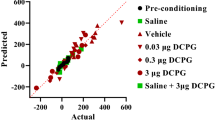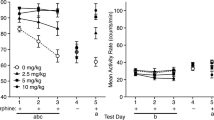Abstract
The purpose of the present study was to reassess the original findings of Carboni et al. (1988) who suggested that 5-HT3 receptor antagonists may block morphine-induced place conditioning in rats. These workers used a biased protocol with treatments allocated to compartments based on initial preference. In the present study we have adopted an unbiased approach with treatments randomly assigned to conditioning compartment in a counter-balanced fashion. Thus treatments were equally paired between distinct environmental cues. Using this protocol, morphine produced a dose-related place preference (0.3–3 mg/kg SC). Thirty-minute pretreatment with the selective 5-HT3 antagonists, MDL72222 (1 mg/kg SC) and ondansetron (0.01 mg/kg SC) before morphine (1.5 mg/kg SC), significantly antagonized the place conditioning to this treatment. However, with higher doses of ondansetron (0.1–1 mg/kg SC), the antagonism of morphine-induced place preference became variable and dependent on the conditioning compartment. This was probably a reflection of the fact that ondansetron when administered alone also appeared to produce an environmentally dependent place conditioning at these doses. Therefore it is concluded that at certain doses, 5-HT3 receptor antagonists may antagonize morphine place conditioning in a manner consistent with a blockade of the appetitive effects of this drug. However, at higher doses, at least with ondansetron, this antagonism became non-specific and dependent on the training environment. It is suggested that other animal models of opioid reinforcement (e.g., self-administration) are now needed to validate the hypothesis that 5-HT3 receptor antagonists may modify opioid reward.
Similar content being viewed by others
References
Bardo MT, Miller JS, Neisewander JL (1984) Conditioned place preference with morphine: the effect of extinction training on the reinforcing CR. Pharmacol Biochem Behav 21:545–549
Barnes JM, Barnes NM, Champaneria S, Costall B, Naylor RJ (1990) Characterisation and autoradiographic localisation of 5-HT3 receptor recognition sites identified with [3H]-(S)-zacopride in the forebrain of the rat. Neuropharmacology 29:1037–1046
Belluzzi JD, Stein L (1977) Enkephalin may mediate euphoria and drive-reduction reward. Nature 266:556–558
Bozarth MA (1987a) Neuroanatomical boundaries of the reward-relevant opiate-receptor field in the ventral tegmental area as mapped by the conditioned place preference method in rats. Brain Res 414:77–84
Bozarth MA (1987b) An overview of assessing drug reinforcement. In: Bozarth MA (ed) Methods of assessing the reinforcing properties of abused drugs. Springer, Berlin Heidelberg New York pp 635–658
Bozarth MA, Wise RA (1981) Intracranial self-administration of morphine into the ventral tegmental area in rats. Life Sci 28:551–555
Broekkamp CL, Phillips AG, Cools AR (1979) Facilitation of self-stimulation behaviour following intracerebral microinjections of opioids into the ventral tegmental area. Pharmacol Biochem Behav 11:289–295
Butler A, Hill JJ, Ireland SJ, Jordan CC, Tyers MB (1988) Pharmacological properties of GR38032F, a novel antagonist at 5-HT3 receptors. Br J Pharmacol 94:397–412
Carboni E, Acquas E, Leone P, Perezzani L, Di Chiara G (1988) 5-HT3 receptor antagonists block morphine- and nicotine-induced place-preference conditioning. Eur J Pharmacol 151:159–160
Carboni E, Acquas E, Leone P, Di Chiara G (1989a) 5-HT3 receptor antagonists block morphine- and nicotine- but not amphetamine-induced reward. Psychopharmacology 97:175–178
Carboni E, Acquas E, Frau R, Di Chiara G (1989b) Differential inhibitory effects of a 5-HT3 antagonist on drug-induced stimulation of dopamine release. Eur J Pharmacol 164:515–519
Carr GD, Fibiger HC, Phillips AG (1989) Conditioned place preference as a measure of drug reward. In: Liebman JM, Cooper SJ (eds) The neuropharmacological basis of reward. Oxford University Press, Oxford, pp 264–319
Chen J, van Praag HM, Gardner EL (1991) Activation of 5-HT3 receptor by 1-phenylbiguanide increases dopamine release in the rat nucleus accumbens. Brain Res 543:354–357
Christoffersen CL, Serpa KA, Meltzer LT (1988) Effects of the serotonin-3 (5-HT3) antagonist, GR38032F, on midbrain dopamine (DA) neurons. Soc Neurosci Abstr 339:13
Costall B, Domeney AM, Naylor RJ, Tyers MB (1987) Inhibition by 5-HT3 antagonists of hyperactivity caused by dopamine infusion into the rat accumbens. Br J Pharmacol 93:194p
Costall B, Naylor RJ, Tyers MB (1988) Recent advances in the neuropharmacology of 5-HT3 agonists and antagonists. Rev Neurosci 2:41–65
Cutler MG (1990) Behavioural effects in gerbils of the 5-HT3 receptor antagonists, BRL43694 and ICS205-930, under circumstances of high and low light intensity. Neuropharmacology 29:515–520
Di Chiara G, Imperato A (1988) drugs abused by humans preferentially increase synaptic dopamine concentrations in the mesolimbic system of freely moving rats. Proc Natl Acad Sci USA 85:5274–5278
File SE (1986) Aversive and appetitive properties of anxiogenic and anxiolytic agents. Behav Brain Res 21:189–194
Glaum SR, Proudfit HK, Anderson EG (1988) Reversal of the antinociceptive effects of intrathecally administered serotonin in the rat by a selective 5-HT3 receptor antagonist. Neurosci Lett 95:313–317
Hagan RM, Jones BJ, Jordan CC, Tyers MB (1990) Effect of 5-HT3 receptor antagonists on responses to selective activation of mesolimbic dopaminergic pathways in the rat. Br J Pharmacol 99:227–232
Higgins GA, Nguyen P, Joharchi N, Sellers EM (1991a) Effects of 5-HT3 receptor antagonists on behavioural indices of morphine reward and withdrawal. Br J Pharmacol 102:144p
Higgins GA, Jones BJ, Oakley NR, Tyers MB (1991b) Evidence that the amygdala is involved in the disinhibitory effect of 5-HT3 receptor antagonists. Psychopharmacology 104:545–551
Jiang LH, Ashby CR Jr, Kasser RJ, Wang RY (1990) The effect of intraventricular administration of the 5-HT3 receptor agonist 2-methylserotonin on the release of dopamine in the nucleus accumbens: an in vivo chronocoulometric study. Brain Res 513:156–160
Kilpatrick GJ, Bunce KT, Tyers MB (1990) 5-HT3 receptors. Med Res Rev 10:441–475
Marcus R, Kornetsky C (1974) Negative and positive intracranial reinforcement thresholds: effects of morphine. Psychopharmacology 38:1–13
Mitchell EA, Pratt JA (1991) Neuroanatomical structures involved in the action of the 5-HT3 antagonist ondansetron: a 2-deoxyglucose autoradiographic study in the rat. Brain Res 538:289–294
Mucha RF, Iversen SD (1984) Reinforcing properties of morphine and naloxone revealed by conditioned place preferences: a procedural examination. Psychopharmacology 82:241–247
Mucha RF, Van der Kooy D, O'Shaughnessy M, Bucenieks P (1982) Drug reinforcement studied by the use of place conditioning in rat. Brain Res 243:91–105
Phillips AG, Le Paine FG (1980) Reinforcing effects of morphine microinjection into the ventral tegmental area. Pharmacol Biochem Behav 12:965–968
Richardson BP, Engel G (1986) The pharmacology and function of 5-HT3 receptors. TINS 9:424–428
Sellers EM, Sobell MB, Higgins GA (1990) Role of 5-HT receptors in addictive disorders. Clin Neuropharmacol 13:234–235
Smith JE, Shultz K, Co C, Goeders N, Dworkin S (1987) Effects of 5,7-dihydroxytryptamine lesions of the nucleus accumbens on rat intravenous morphine self-administration. Pharmacol Biochem Behav 26:607–612
Spanagel R, Herz A, Shippenberg TS (1990) The effects of opioid peptides on dopamine release in the nucleus accumbens: an in vivo microdialysis study. J Neurochem 55:1734–1740
Spyraki C, Nomikos GG, Galanopoulou P, Daifotis Z (1988) Drug-induced place preference in rats with 5,7-dihydroxytryptamine lesions of the nucleus accumbens. Behav Brain Res 29:127–134
Waeber C, Pinkus LM, Palacios JM (1990) The (S)-isomer of [3H] zacopride labels 5-HT3 receptors with high affinity in rat brain. Eur J Pharmacol 181:283–287
Wise RA, Bozarth MA (1984) Brain reward circuitry: four circuit elements “wired” in apparent series. Brain Res Bull 12:203–208
Author information
Authors and Affiliations
Additional information
The views expressed in this publication are those of the authors and do not necessarily reflect those of the Addiction Research Foundation.
Rights and permissions
About this article
Cite this article
Higgins, G.A., Joharchi, N., Nguyen, P. et al. Effect of the 5-HT3 receptor antagonists, MDL72222 and ondansetron on morphine place conditioning. Psychopharmacology 106, 315–320 (1992). https://doi.org/10.1007/BF02245411
Received:
Revised:
Issue Date:
DOI: https://doi.org/10.1007/BF02245411




